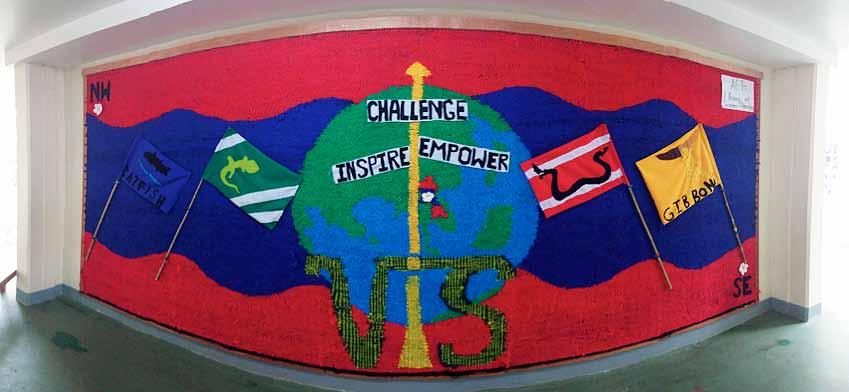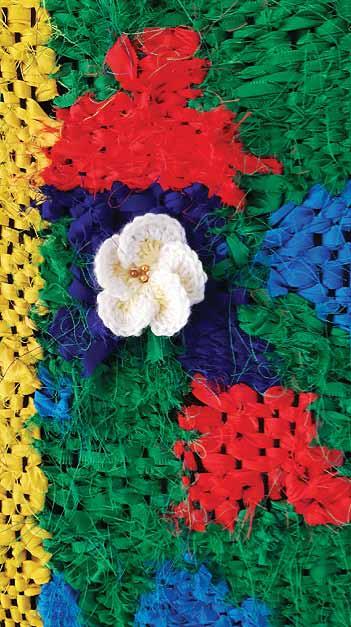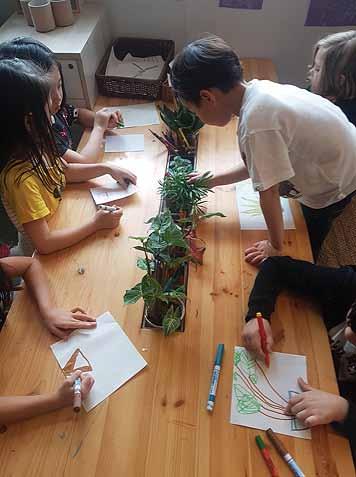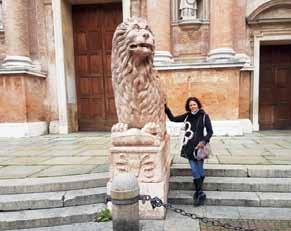
6 minute read
Art and Community Identity
ACT: A Community Tapestry
At Vientiane International School (VIS), we gather together before the students arrive each year so we can reconnect with our mission and with each other. During our first session, our new Head of School, Elsa Donohue, asked us to stand and follow a few straight-forward directions; close your eyes, turn around three times, and then point North. Simple enough. It is easy to visualize what we saw next. There before us were fingers pointing every which way but down! It was clear we needed a compass to find our way. Interestingly enough, the word ‘compass’ actually translates to ‘together way’ in Latin. This simple tool unites us so we, as a global community, can share a dialogue about where we are and where we are going. Experiences like these can inspire exciting artistic inquiries into how we show who we are, where we are, and where we want to go.
From a Visual Arts perspective, I felt consumed by the idea of a compass as a tool to unite people. As the days passed, I had conversations with students, teachers, parents, and anyone who would listen about a shared belief in a concept, about how when we agree on a direction, we can move forward to a new place, together. It was at this time that I asked the students across the grade levels to create an image that represented who we are as a school community, where we are in the world, and what we hope for our students to gain from being at our school. With these three goals in mind, the unimagined came to life. Who are we as a community? How can we represent ourselves through the elements of art? How can shape, color, or space define us? We are The VIS Dragons! Many students used this image to illustrate our community. Others thought that our Houses of Gibbons, Geckos, Catfish, and Nagas described us best, while still others felt that the image of a world was symbolic of our international school.
Where are we in the world? Lao PDR is our home and host country. Students generated images of dok champa (the national flower), That Luang (the national temple), and the Lao flag to locate us in the world. Even more students felt that we should use the outline of the country to communicate to our audience.
What do we hope for our students to gain from being at VIS? Attributes like principled, knowledgeable, and caring came into focus, as did images of reading, writing, and arithmetic. Our mission statement came through in the end. Challenge, Inspire, and Empower! It is hard to imagine better goals for children.
The best metaphor came through in crafting the artwork itself with nearly 400 participants from over 40 different countries. Primary, Secondary, parents, and staff all came together to create a vision. A Community Tapestry: ACT! The act of envisioning, collaborating, and creating this over 16 square meter wall hanging with warp and weft symbolizing the cardinal directions while visually representing who we are, where we are, and our mission proved to do just that: Challenge, Inspire, and Empower!

Close-up of the image of Lao PDR representing a symbolic flag with the national flower at the center.
Curriculum Initiatives Can You Speak 100 Languages?

Every day I wake up thinking how lucky and privileged I am to have the job I do. After more than 20 years of being a teacher I am still changing, evolving and experimenting. I am an Early Years art teacher at UNIS, Hanoi. My working week consists of thirty-five 40 minute periods talking about art, creating art, opening up possibilities to explore ideas, materials and thoughts, with over 200 3-7 year olds. Why do I think this is such a special job? Well ….

Last November I visited the town of Reggio Emilia in Italy. I am sure many of you already know Reggio Emilia as being famous for the inventive, creative and extremely successful early years education programme which was set up there after the end of WW2. There are three main components which make the programme so successful, and now well regarded all over the world. It looks to the child, the environment and the community.
It is a system without formal assessment, no curriculum as we would understand it, and with the voice of the child central to everything. What has also always particularly interested me is the Reggio Emilia concept of 100 “languages”. This idea looks to each child being an individual who can express their ideas and thoughts in 100 different ways, or even more. These “languages” are often expressed with many different materials. There is a focus on the arts and an acknowledgment of the beauty of our world and how we can capture it. International education is always evolving; we gain knowledge and experience from many different people and places. Currently we look to “inquiry” as the best way to engage our children. We think about student agency and valuing the student voice. We look to the future wanting to develop our children into adults, who are adaptable to the unknown, who are problem solvers. Children who become empathetic adults who can help shape our rapidly changing world. After visiting Reggio Emilia and taking their week-long course for International Teachers I came to understand that their education system has been driven by all of these considerations, since its inception in 1946. It is a system which works outstandingly well; and we can definitely look to it to help us change education for the better. In an article written in 1991, Newsweek suggested that the Reggio education system was amongst the top ten in the world. My personal experience of the system is such that I believe this still holds good today.

On arriving back in Hanoi, I felt inspired to try new ideas; to make each child’s experience in the Art Room more meaningful and personal. This was not something completely new to me and I had already done much to create an environment which I felt was safe and reassuring; a place to take risks, where a mistake can be turned into something beautiful, where anything can be possible. By Emma Hamilton ES Art Teacher (ECC-Grade 2) and ES Arts Team Leader United Nations International School of Hanoi
Children at UNIS expressing themselves through their different languages

What I have changed is the way I listen, and the way I act on children’s thoughts and ideas. I am now trying consciously to connect their views and ideas, and act upon them. We have an art curriculum, but rather than the emphasis being on a finished product I am now trying to look at each unit being like a Reggio project. The basis for each unit comes from our PYP POI, but how each unit proceeds is driven by the children – I listen carefully to their ideas, and we discuss how we can proceed as a class, or in smaller groups.
I truly believe my visit to Reggio Emilia will improve the experience my art pupils receive. Giving students a voice, listening to their ideas and acting upon them will do much to create a truly worthwhile Visual Arts programme.











